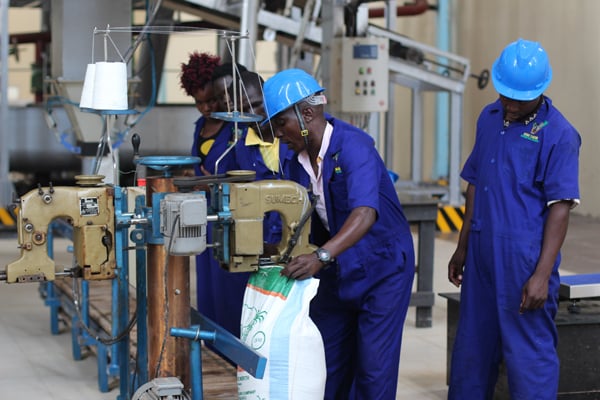Prime
Museveni orders inquest into the sugar sub-sector

Workers at Atiak Sugar Works Ltd last year. The company suspended sugar production due to a reduction in the supply of sugarcane to the factory. PHOTO / TOBBIAS JOLLY OWINY
What you need to know:
- The President’s move comes at a time when sugar production in the country has dipped.
President Museveni has commissioned the Economic Policy Research Centre (EPCR) to carry out a comprehensive research on the sugar industry amid concerns that an increase in the number of licensed sugar mills has not led to an increase in sugar production in the country.
“The President assigned EPCR to carry out an urgent comprehensive study of the sugar industry and make recommendations on how best it can be helped,” a source at the Uganda Sugar Manufacturers’ Association (USMA) told Sunday Monitor earlier this week.
Dr Sarah Ssewanyana, the EPRC executive director, confirmed the development on Thursday. She, however, hastened to add that the President’s directive came at a time when the Centre had already carried out some research on the operations of the industry in the sugarcane growing parts of Buganda, Busoga and Bunyoro sub-regions.
“That one (commissioning of EPRC) came later when they requested for some kind of write-up, but it came after we had already conceived that research. It (EPCR’s research) might have boosted the demand for evidence,” Dr Ssewanyana said.
Mr Museveni’s move comes at a time when sugar production in the country has dipped. At least three of Uganda’s biggest millers—Kinyara Sugar, the Sugar Corporation of Uganda Limited (Scoul) and Kakira Sugar—reported challenges in accessing raw sugarcane to feed into their operations in July.
The mills reported that they were as a result of not operating at optimum installed production capacity, a situation which Mr Mwine Jim Kabeho, the USMA chairman, said would inevitably result in a production shortfall.
“The estimated sugar production for 2022 is 822,000 metric tonnes, out of which 720,000 tonnes is meant to be brown sugar and 60,000 tonnes industrial sugar. The shortages of cane mean we are highly unlikely to meet those targets,” Mr Kabeho said in an earlier interview.
The situation, it was feared, would result in shortages which would translate into an increase in the shelf price of processed sugar.
That came to pass with an increase of the Consumer Price Index from 7.9 percent in August to 9 percent in September, with a 1.8 percent increment in the prices of food and non-alcoholic beverages, the manufacture of most of which takes in huge volumes of sugar.
Dr Ssewanyana said research will basically look at how both the National Sugar Policy and the Sugarcane Act are likely to impact the industry and whether the government and Parliament should take another look at the issue of creating zones for existing sugar mills.
“There was an element whether we should bring back zoning or not,” she said, adding, “But talking to the players in the sector, you find that there are mixed feelings about zoning.”
While it has been discovered that traditional millers support zoning, smaller operators are opposed to it.
The EPCR will also look at the Kenya sugar industry since it experienced challenges similar to what the Ugandan industry is grappling with.
A case for zoning
The paper also calls on the government to take another look at zoning, arguing that large mills are resorting to setting up their own estates, which is a threat to the future of outgrower production as an economic activity.
“In the absence of zoning, large mills are arguably resorting to expanding nucleus estates to stabilise cane supplies. However, the expansion of nucleus estates is beginning to crowd out outgrowers in cane production by reducing large mills’ demand for outgrower cane. This could significantly reduce the sugarcane industry’s ability to serve as a source of inclusive economic growth in rural areas,” the report warns.
11,000 quit sugarcane
In a related development, research carried out by the EPRC between November and December 2021 revealed that 11,000 households in Busoga, Buganda and Bunyoro—which had been involved in sugarcane farming—abandoned the activity.
“More households took up cane growing during the period between 2012 and 2021, and an estimated 40,000 households, at one point, took part in sugarcane growing between 2005 and 2021,” the research report released on Wednesday states. “But by the time data were collected in December 2021, this number had declined to about 29,000.”
The report also indicates that the highest number of farmers, who abandoned cane growing, is in Busoga Sub-region.
“Twenty-eight percent of outgrowers had abandoned cane growing,” the report further states.
Farmers, the report notes, had mainly been attracted to sugarcane growing because of the high prices of cane in the period between 2006 and 2017. They were, however, forced to quit due to, among others, lack of market for their cane and a fall in cane prices in the period between March 2020 and September 2021.
The report calls on the government to expedite implementation of provisions of the 2020 Sugar Act, especially creation of functioning outgrowers’ associations to help with negotiating prices of cane. It also pushes for formation of a National Sugar Board (NSB) to oversee and regulate activities of cane growing.
“Without the NSB, miller and grower agreements are broken. Under such circumstances, the survival of the outgrower schemes is under threat due to increased market uncertainties among outgrowers. This is the reason behind the exit of outgrower farmers from sugarcane cultivation,” the report recommends.




